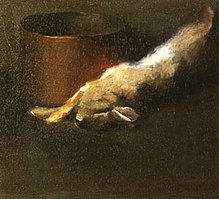
Georgia Totto O'Keeffe was an American modernist painter and draftswoman whose career spanned seven decades and whose work remained largely independent of major art movements. Called the "Mother of American modernism", O'Keeffe gained international recognition for her meticulous paintings of natural forms, particularly flowers and desert-inspired landscapes, which were often drawn from and related to places and environments in which she lived.

Alfred Stieglitz was an American photographer and modern art promoter who was instrumental over his 50-year career in making photography an accepted art form. In addition to his photography, Stieglitz was known for the New York art galleries that he ran in the early part of the 20th century, where he introduced many avant-garde European artists to the U.S. He was married to painter Georgia O'Keeffe.

The Georgia O'Keeffe Museum is dedicated to the artistic legacy of Georgia O'Keeffe, her life, American modernism, and public engagement. It opened on July 17, 1997, eleven years after the artist's death. It comprises multiple sites in two locations: Santa Fe, New Mexico, and Abiquiu, New Mexico. In addition to the founding Georgia O'Keeffe Museum in Santa Fe, the O'Keeffe includes: the Library and Archive within its research center at the historic A.M. Bergere house; the Education Annex for youth and public programming; Georgia O'Keeffe's historic Abiquiu Home and Studio; the O'Keeffe Welcome Center in Abiquiu; and Museum Stores in both Santa Fe and Abiquiu. Georgia O'Keeffe's additional home at the Ghost Ranch property is also part of the O'Keeffe Museum's assets, but is not open to the public.
Ellen Bryant Voigt is an American poet. She served as the Poet Laureate of Vermont.

Maurice Wertheim was an American investment banker, chess player, chess patron, art collector, environmentalist, and philanthropist. Wertheim founded Wertheim & Co. in 1927.
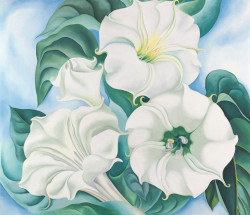
Jimson Weed is an oil on linen painting by American artist Georgia O'Keeffe from 1936, located in the Indianapolis Museum of Art in Indianapolis, Indiana. It depicts four large blossoms of jimson weed. A similar work by O'Keeffe, Jimson Weed/White Flower No. 1, was sold by the Georgia O'Keeffe Museum at auction to Walmart heiress Alice Walton in 2014 for $44,405,000, more than tripling the previous world auction record for a piece by a female artist.
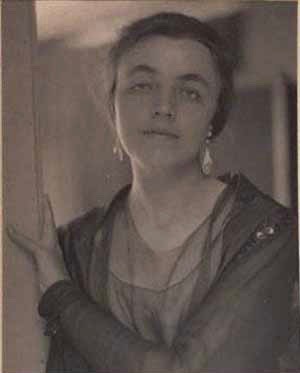
Katharine Nash Rhoades was an American painter, poet and illustrator born in New York City. She was also a feminist.

Marion Hasbrouck Beckett was an American painter.
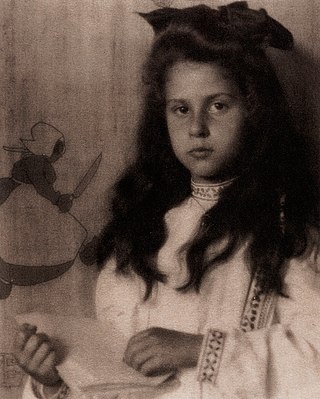
Katherine Stieglitz, or Katherine Stieglitz Stearns, was the daughter of Emmeline, or Emmy, and Alfred Stieglitz, an American photographer and modern art promoter. She was the subject of many of her father's photographs, particularly in her early years. They were exhibited and received praise for their wholesome sentiment. She graduated from Smith College before marrying Milton Sprague Stearns. After the birth of her son in 1923, she was institutionalized for depression and hallucinations and remained there until her death in 1971.

Georgia O'Keeffe made a number of Red Canna paintings of the canna lily plant, first in watercolor, such as a red canna flower bouquet painted in 1915, but primarily abstract paintings of close-up images in oil. O'Keeffe said that she made the paintings to reflect the way she herself saw flowers, although others have called her depictions erotic, and compared them to female genitalia. O'Keeffe said they had misconstrued her intentions for doing her flower paintings: "Well – I made you take time to look at what I saw and when you took time to really notice my flower you hung all your own associations with flowers on my flower and you write about my flower as if I think and see what you think and see of the flower – and I don't."

O’Keeffe at the University of Virginia, 1912–1914 is an exhibition of watercolors that Georgia O'Keeffe created over three summers in the early 20th century at the University of Virginia. Shown at the Georgia O'Keeffe Museum in Santa Fe, New Mexico, the exhibit opened November 4, 2016 and ran through September 10, 2017. A year later, on October 19, 2018, the exhibition opened at the Fralin Museum of Art on the grounds of the University of Virginia, where it remained on display until January 27, 2019.
Light Coming on the Plains is the name of three watercolor paintings made by Georgia O'Keeffe in 1917. They were made when O'Keeffe was teaching at West Texas State Normal College in Canyon, Texas. They reflect the evolution of her work towards pure abstraction, and an early American modernist landscape. It was unique for its time. Compared to Sunrise that she painted one year earlier, it was simpler and more abstract.

The Flag is a painting by Georgia O'Keeffe (1918), that represents her anxiety about her brother being sent to fight in Europe during World War I, a war that was particularly controversial and dangerous due to its use of new modern weapons and tactics, like the machine gun, mustard gas, naval mines and torpedoes, high-powered artillery guns, and combat aircraft. Due to government restrictions on the freedom of speech included in the Espionage Act of 1917 the painting was not displayed until 1968. It is in the collection of the Milwaukee Art Museum.

Black Iris, sometimes called Black Iris III, is a 1926 oil painting by Georgia O'Keeffe. Art historian Linda Nochlin interpreted Black Iris as a morphological metaphor for female genitalia. O'Keeffe rejected such interpretations in a 1939 text accompanying an exhibition of her work by writing: "Well—I made you take time to look at what I saw and when you took time to really notice my flower you hung all your own associations with flowers on my flower and you write about my flower as if I think and see what you think and see of the flower—and I don't." She attempted to do away with sexualized readings of her work by adding a lot of detail.

Blue is the name of four paintings that Georgia O'Keeffe made in 1916. It was one of the sets of watercolors that she made exploring a monochromatic palette with designs that were non-representational of specific objects. The paintings were made on 15+7⁄8-by-11-inch sheets of Japanese tissue of the gampi tree.

Georgia O'Keeffe made a set of paintings of Palo Duro Canyon while working as a department head and art instructor at West Texas State Normal College. The vibrant paintings reflect her development as an Abstract Expressionist, influenced by Arthur Wesley Dow.

The American artist Georgia O'Keeffe is best known for her close-up, or large-scale flower paintings, which she painted from the mid-1920s through the 1950s. She made about 200 paintings of flowers of the more than 2,000 paintings that she made over her career. One of her paintings, Jimson Weed, sold for $44.4 million, making it the most expensive painting sold of a female artist's work as of 2014.

Ida Ten Eyck O'Keeffe was an American visual artist known for oil paintings, watercolors, and monotypes. She was the younger sister of painter Georgia O'Keeffe.
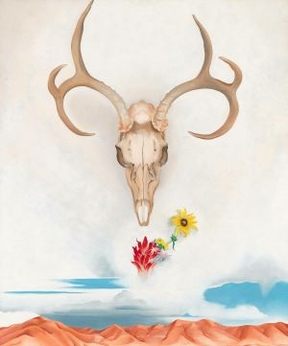
Summer Days is a 1936 oil painting by the American 20th-century artist Georgia O'Keeffe. It depicts a buck deer skull with large antlers juxtaposed with a vibrant assortment of wildflowers hovering below. The skull and flowers are suspended over a mountainous desert landscape occupying the lower part of the composition. Summer Days is among several landscape paintings featuring animal skulls and inspired by New Mexico desert O'Keeffe completed between 1934 and 1936.

Sky Above Clouds (1960–1977) is a series of cloudscape paintings by American artist Georgia O'Keeffe produced during her late period. The works were completed at her home and studio in Abiquiú and at her Ghost Ranch studio in Rio Arriba County, New Mexico. Only four paintings in the series share the same motif–a pink sky above the horizon with patches of cloudlets, or cloud streets below it, progressing from smaller to larger canvases. The motif was inspired by views from her airplane window during her frequent air travel in the 1950s and early 1960s when she flew around the world. Sky above Clouds IV, the fourth version in the shared motif of the series, is two meters high and seven meters wide. It is the largest painting ever created by the artist, accomplished at the age of 77 in the summer of 1965. Two of the paintings in the series are held by private collectors, while the rest are found in the National Gallery of Art, the Georgia O'Keeffe Museum, and the Art Institute of Chicago.


